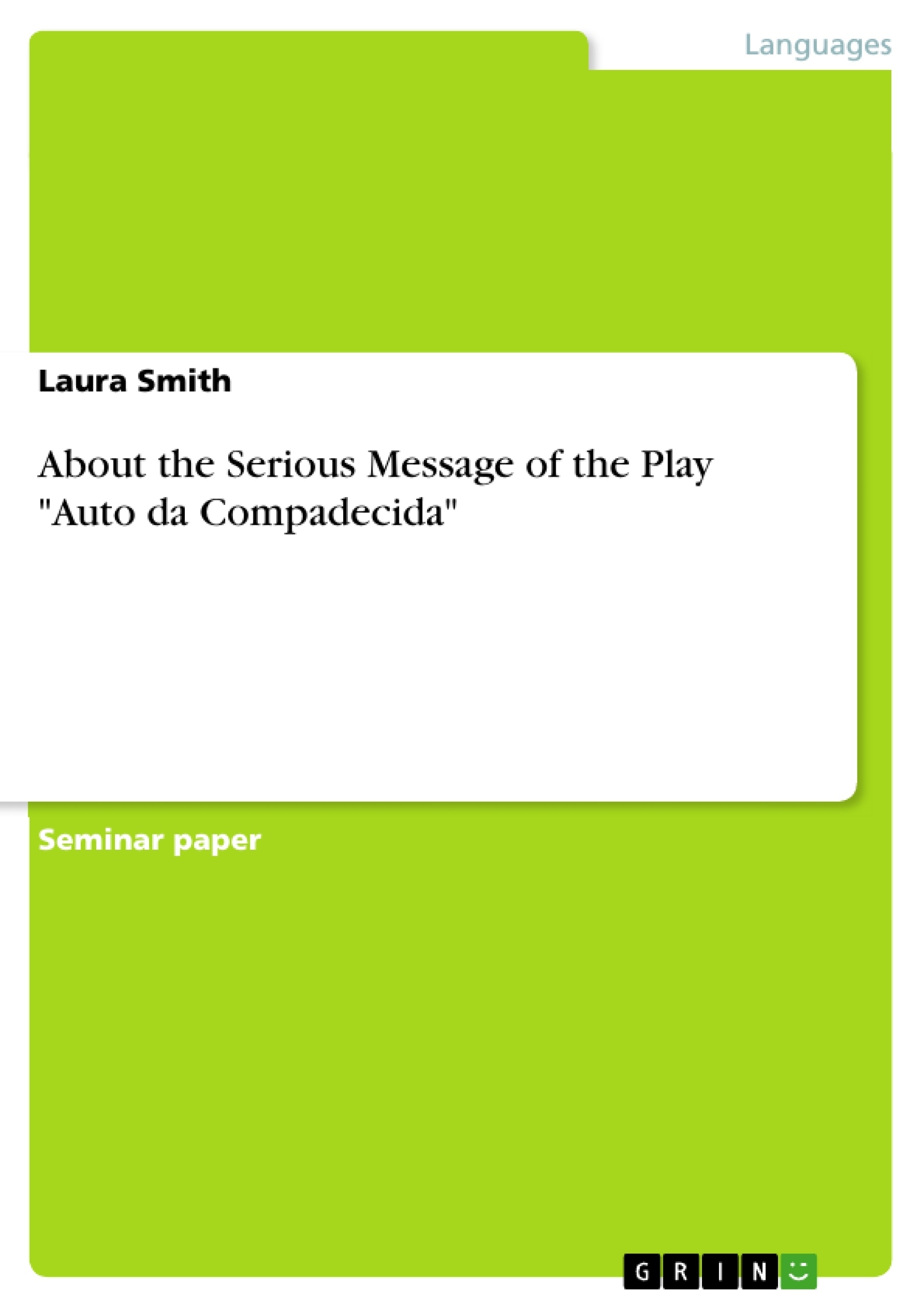“[Auto da Compadecida] constrói-se a partir dos textos múltiplos que ... se mesclam.” (Santos: 1999, 265). Here Santos has described one of the defining characteristics of the text. Perhaps this mix of elements is a contributing factor to Sussasuna’s universal popularity – the undeniably comedic elements, except those relevant only to a Northeast Brazilian audience, are certainly entertaining in any language. Maybe the ‘serious message’, which could indeed reasonably be said to form the ‘heart of the play’, is as well so universal in nature that it addresses any audience. In order to access this message, however, the audience must at first be entertained and subtly educated. I would argue that the comic elements, though obvious, are integral to this process, rather than existing as an inferior technique ‘despite’ which the moral can be communicated.
5. Despite the outwardly/obvious comic elements of the play, at the heart of “Auto da Compadecida” there remains a deeply serious message.
“[Auto da Compadecida] constrói-se a partir dos textos múltiplos que ... se mesclam.” (Santos: 1999, 265). Here Santos has described one of the defining characteristics of the text. Perhaps this mix of elements is a contributing factor to Sussasuna’s universal popularity – the undeniably comedic elements, except those relevant only to a Northeast Brazilian audience, are certainly entertaining in any language. Maybe the ‘serious message’, which could indeed reasonably be said to form the ‘heart of the play’, is as well so universal in nature that it addresses any audience. In order to access this message, however, the audience must at first be entertained and subtly educated. I would argue that the comic elements, though obvious, are integral to this process, rather than existing as an inferior technique ‘despite’ which the moral can be communicated.
Tales for children are made entertaining to enable them to instruct. There are many side stories in Auto da Compadecida which act as humorous interludes, some of which have moral purpose themselves, or which merely complement the main narrative. In one such instance, the poor boy Chicó, tells of a fish that once dragged him up the Amazon for three days and three nights. (Susassuna: 1955, Act 1). By this point in the play, Chicó is known to be a teller of tall tales and he is the centre of many humorous scenes, with the poor but quick-witted João Grilho adding a sarcastic comment or two each time.
The work of Aristotle, specifically his Poetics, confirms the above as an example of a classic feature of a traditional comedy. The Greek philosopher and dramatic theorist claimed that “Comedy is, as I have said, an imitation of lower types.” (unknown, 23). That is to say, the friendly mocking directed at Chicó and the various misfortunes of he and João Grilho mean that the two poor men just about fit into the category of person which Aristotle would deem relatable and which make the comedy both successfully entertaining and informative. Such an element is invaluable and should reinforce the drama.
Susassuna, to the contrary, deems most of these scenes easily removed from the narrative, with no adverse effects. On several occasion the stage directions hold instructions along the lines of “This scene can, if the director wishes, be cut from here...” (Act 1). Obviously Suassuna does not consider Chicó’s comedic tales necessary, which would suggest that the play concentrates on the ‘deeply serious message’.
As a founding member of the Armorial Movement in Northeast Brazil, Susassuna was concerned with the fact that he saw ‘two Brazils’ due to the “two distinct social classes” (Slater: Winter 1979, 164).He wanted to draw attention to various social and political themes having to do with the state of Brazil in the Twentieth Century, and he understood that when it comes to drama, it is necessary to keep a certain flow. Dillwyn Ratcliff (1961, 283) confirms that “[Sussuna] generously suggests a number of appropriate “cuts” to shorten the piece and also to keep the principal theme in focus.” With many different points demanding attention, it is possible that Suassuna regards much of the comedy disposable in the face of more important purposes, and parts of his play were included merely to “attract a maximum number of customers” (Slater: Winter 1979, 164). A few jokes and stereotypes bring in the numbers and enable the messages contained within the important scenes to reach a wider audience.
It certainly seems that not all scenes, including the aforementioned fish tale, support the message at the heart of the play but it is undeniable that without a number of sequences, which themselves are irrefutably comedic, the play would fall apart. Such sequences have often been interpreted as farce. Cafezeiro and Gadelha (1996, 204) agree that “Um componente que marca a comédia...é o farsesto.” If one accepts the statement that farce is a key component of a comedy, it follows that Auto is in fact of the comedy genre, as many of the most memorable and important scenes are, in essence, farce.
The priest’s encounter with Antonio Morais in Act 1 is a clear illustration of the technique:
Morais Of course! If my ancestors came over then, naturally his did too. What are you trying to insinuate? Do you perhaps mean to say that his mother...
Priest Why, she is a bitch!
Morais A what?
Priest A bitch.
Morais Repeat that.
Priest I don’t see any harm in repeating it. She is a bitch, is she not?
[...]
- Quote paper
- Laura Smith (Author), 2013, About the Serious Message of the Play "Auto da Compadecida", Munich, GRIN Verlag, https://www.grin.com/document/295716
-

-

-

-
Upload your own papers! Earn money and win an iPhone X. -

-
Upload your own papers! Earn money and win an iPhone X. -

-
Upload your own papers! Earn money and win an iPhone X. -

-
Upload your own papers! Earn money and win an iPhone X. -

-
Upload your own papers! Earn money and win an iPhone X.

